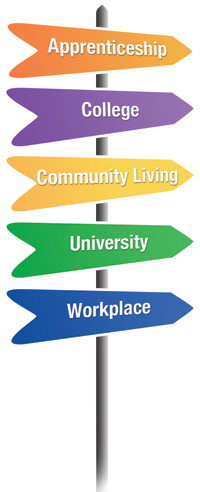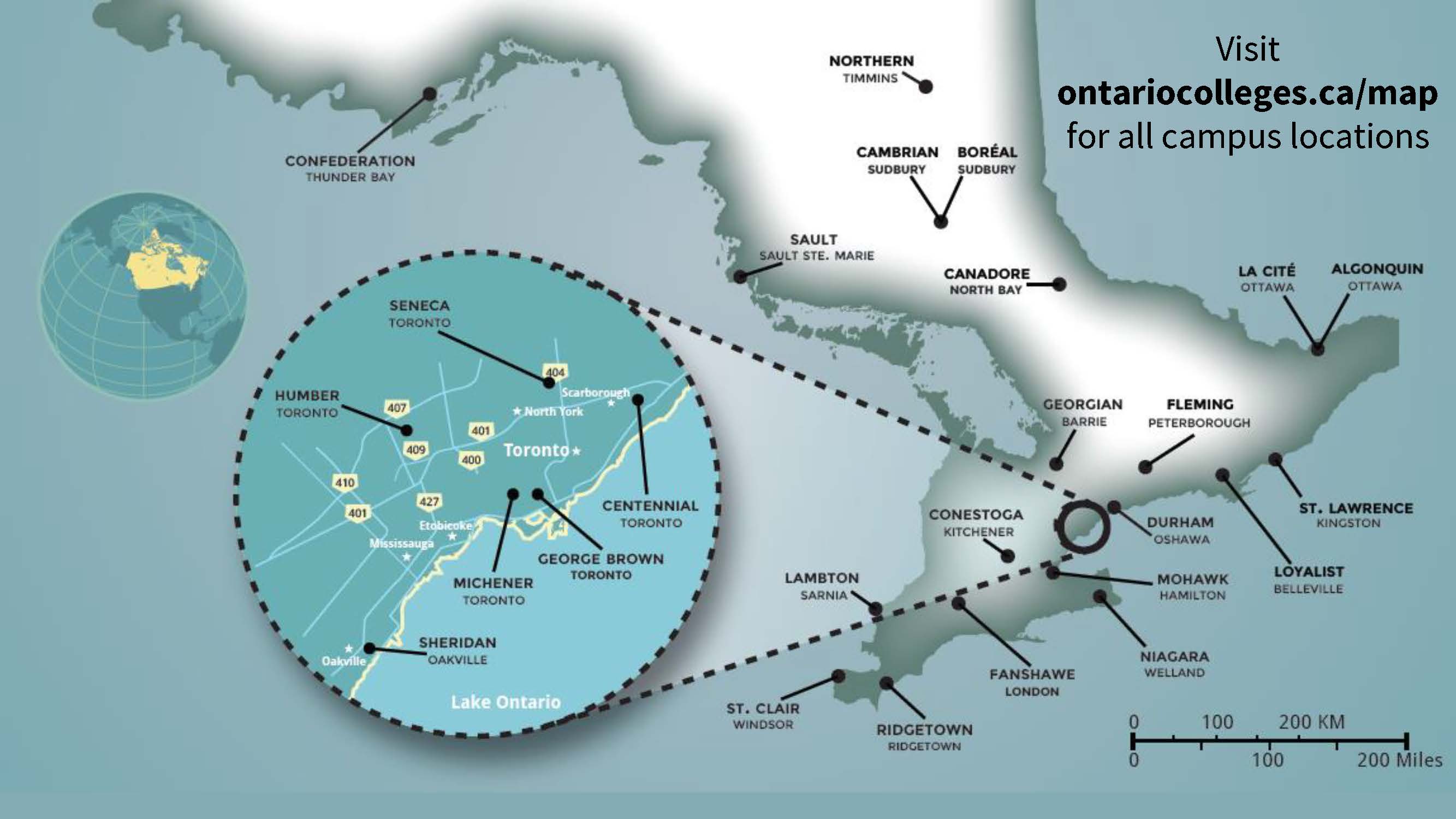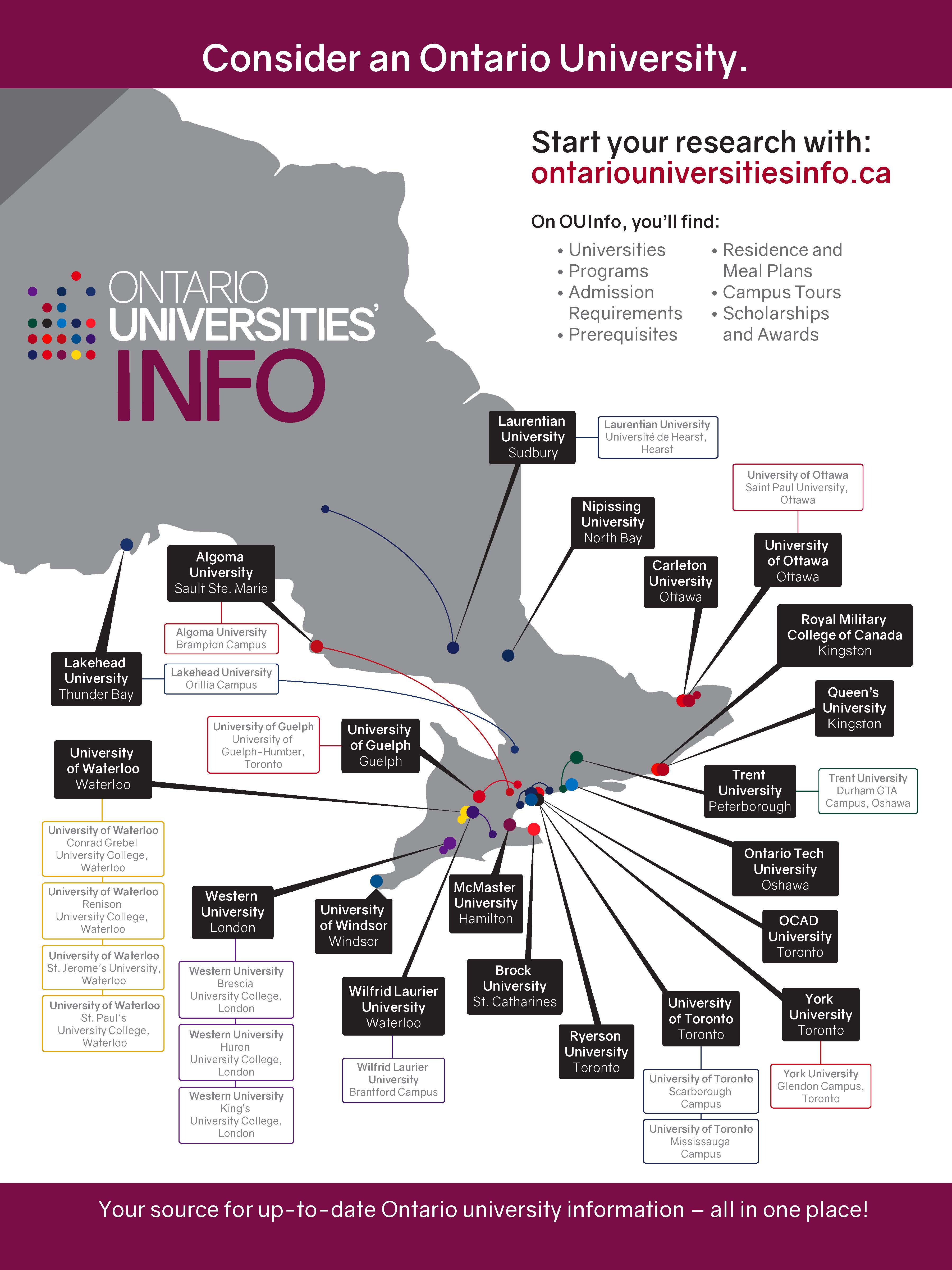
Post-Secondary Pathways
 Students, parents and teachers are life-long learners. The idea of planning a pathway toward an educational goal should be focused, yet flexible. Educational goals can change over time. The ultimate goal of a student is to find and enjoy meaningful work.
Students, parents and teachers are life-long learners. The idea of planning a pathway toward an educational goal should be focused, yet flexible. Educational goals can change over time. The ultimate goal of a student is to find and enjoy meaningful work.
There are many ways to journey toward work or a career/vocation. The pathways planning journey involves the transition from grade-to-grade and to life after high school to one of the post-secondary destinations of:
- Apprenticeship
- College
- Community Living
- University
- Workplace
Researching Your Options
In order to become better informed about your post-secondary choices, it's never too early to start researching your options. Visit your Guidance Teacher, myBlueprint, or a Post-Secondary Fair for more details.
- St. Mary: Post-Secondary Newsletter (2024-2025)
- St. Mary: Transition Plan Worksheet
- St. Mary: Post-Secondary Planner Worksheet
- St. Mary: Grade 12 Post-Secondary Info Session (September 2024)
- Ontario University Fair: Saturday October 5 & Sunday October 6 (10am - 5pm)
- St. Mary: Post-Secondary Information Fair: Thursday October 10 (6:30 - 9 pm)
- Ontario College Information Fair: Wednesday October 16 (5 - 9pm) & Thursday October 17 (9am - 2pm)
- Maclean's Student Life Expo: Saturday October 27 (12 - 5pm)
- DCDSB Student Services - Community Resources Symposium and Fair:
- Go Global Expo:
- US Expo: Saturday April 21 (10am - 2pm)
Apprenticeship |
Apprenticeship a post-secondary pathway that combines on-the-job and in-class technical training with work experience that leads to certification in over 150 skilled trades.
Resources
|
College |
|
Colleges offer a variety of diploma, certificate and applied degree programs. Ontario's publicly-funded colleges offer more than 5,000 program choices in 200+ areas of study. Programs are career-oriented and geared toward marketable skills. Resources
|
Community Living |
| Transition planning is about looking ahead to the future and preparing for adulthood. It is a partnership involving student, parent/guardian, St. Mary and DCDSB staff (e.g., Program Support, Guidance, Administration, Student Services), and community support agencies. Students on this post-secondary pathway may be working towards a Certificate of Accomplishment or a Ontario Secondary School Certificate.
As part of a student's Individual Educational Plan (IEP), a post-secondary transition is developed. Options include, but are not limited to volunteer work, paid employment and participation in recreational programs. Resources
|
University |
|
To apply to university programs, students must earn their Ontario Secondary School Diploma and 6 of their Grade 12 courses must be at the University (U) or University/College (M) Level. There are 21 universities in Ontario, offering professional programs in a variety of fields. Resources Ontario Universities' Info (OUInfo) is a guide to Ontario universities for Ontario high school students and their parents/guardians. It provides information about university programs, admission requirements and more. OUInfo should be used as a starting point for researching university options.
To apply to Ontario Universities, students do so online through Ontario Universities Application Centre (OUAC).
|
Workplace |
|
The goal of all students is to find employment that is fulfilling and of service to society. There are many ways to get to the world of work and one of the ways is through an entry-level job. You may choose to seek the advice of an Employment Counsellor or attend a workshop at one of our Community Agencies. Resources |
Post-Secondary Applications - Key Dates (2024 - 2025) |
||||||||||||||||||||||||
|
Employment Ontario & Canada's Labour Market |
| Ontario Ministry of Advanced Education and Skills Development can help you get the education and training you need to build a rewarding career after high school. You can choose from university and college programs, apprenticeships and many other kinds of training and education. Through Employment Ontario, MAESD's employment and training network, we'll also help you build your career, and keep learning, throughout your working life. Employment Ontario connects people looking for work with employers looking for workers. It's your one-stop source of information about jobs, job search skills, training, education, and other services for employees and employers.
When planning a career-life pathway, students should consider a variety of factors in a chosen career before beginning post-secondary education and/or training. Learn more about an occupation you are interested through Canada's Labour Market Information. Investigate wages, employability outlooks, education, and skills needed for a career. Informed education choices early in life can help young Canadians obtain the skills and experience necessary to find work quickly, avoid unnecessary debt and get a better start to their careers. |
Financial Support, Scholarships, Awards and Grants |
The Ministry of Advanced Education and Skills Development provides a variety of student aid programs:
The Employment and Social Development Canada: Education Planning page is an excellent source of information. The Financial Consumer Agency of Canada also provides a variety of resources for Students and their Parent/Guardians on how to pay for post-secondary education. A recent study showed that 85% of Canadian students will graduate from higher education with an average of $27,000 of debt. It doesn't have to be that way, though, because there are many sources of funding available for higher education - from birth, through to post-graduation - that can make access to post-secondary education possible and reduce potential debt. A Parent's Guide to Funding Higher Education describes sources of funds and resources for each stage. St. Mary students also have access to "The Scholarship Report" via their Edsby account in the Grade 12 Potential Graduates group. "The Scholarship Report" is a bi-monthly digital information resource for high school guidance counsellors, students and parents. It features current national and provincial scholarship listings as well as helpful tips in the search for all forms of post-secondary funding. Information on University/College Open Houses, application deadlines and fees, the Ontario Student Assistance Program (OSAP) and other material pertinent to the graduating high school student is also provided. "The Scholarship Report" also includes listings of other types of awards as well as programs and activities that will enhance students' skills as well as their scholarship applications! Also available at Seeking Scholarships, coaching parents / students on their quest for scholarships, bursaries, and other forms of financial aid for postsecondary education. A scholarship is an award based on a prescribed set of criteria. Scholarships are available from post-secondary institutions, companies or organizations. Speak to a Guidance Counsellor for more information. You may want to begin your research from the following websites:
Visit the Financial Supports and Scholarships webpage for information on financial supports including scholarships, bursaries and awards. |
Gap Year |
| A gap year is a break after secondary school, before making a commitment to an apprenticeship, college, university or the workplace. It can be any length of time, before and during studies, time off from work or other career pursuits and include any number of activities. You can figure out who you are, what your opportunities are, who you want to become and what you need to get there. Students may opt to volunteer, work, travel or explore. See Ontario Ministry of Education gap year fact sheet for more information. |
Post-Secondary Education in the United States (e.g. SAT/ACT, NCAA) |
| Considering attending post-secondary in the United States? See a Guidance Counsellor for more information, and advice on how to select OSSD courses to plan for this pathway. Start your research with these resources: |
Students with IEPs and/or Disabilities |
| If you have an IEP, you are supported by Program Support at St. Mary. Once you transition to Post-Secondary, your support is through Office of Students with Disabilities or Accessibility Centre at the College/University. Incoming students will not automatically receive the same accommodations at college or university that they received at high school. To discuss available accommodations, students should contact the OSD at the post-secondary school directly. Your Guidance Counsellor and Program Support Teacher are also available to assist you.
Resources
|
Post-Secondary Resources for Minority Groups |
|
Black Foundation of Community Networks (BFCN) Scholarship Program. BFCN Scholarship Program is designed to address a few of the gaps and barriers in order to increase access to post-secondary education and support Black students and their families. Includes the BCFN Scholarship Directory and Scholarship Workshop. Aboriginal Post-Secondary Information Program (APSIP). APSIP is a collective of Indigenous (First Nations, Inuit and Métis) representatives from Colleges, Universities, and Indigenous learning institutes in Ontario and Quebec. The collective allows member institutions to engage more Indigenous students and their communities in a cost effective and collaborative manner.
|


